The Rise of Compounded GLP-1 Medications: Strengths, Benefits, and a Promising Future
The landscape of weight management and metabolic health is rapidly evolving, and at the forefront of this transformation are GLP-1 (glucagon-like peptide-1) receptor agonists. Originally developed for diabetes management, these medications have shown remarkable efficacy in promoting weight loss, leading to a surge in demand. Within this burgeoning market, compounded GLP-1 medications are carving out a significant and vital niche, offering unique strengths and benefits that address specific patient needs and market dynamics.
Understanding GLP-1 Medications
GLP-1 agonists work by mimicking the effects of the natural GLP-1 hormone, which plays a crucial role in regulating blood sugar and appetite. They slow down gastric emptying, increase feelings of fullness, and reduce food intake, leading to significant weight reduction and improved glycemic control for many individuals.
The Strengths of Compounded GLP-1s
While brand-name GLP-1 medications are widely recognized, compounded versions, prepared by specialized pharmacies, offer distinct advantages:
- Customized Dosages and Formulations: Compounding allows for tailored dosages that may not be commercially available. This is particularly beneficial for patients who require specific titration schedules, have sensitivities to certain inactive ingredients found in mass-produced drugs, or need combination therapies. Pharmacists can adjust formulations to meet individual patient profiles, potentially improving efficacy and minimizing side effects.
- Addressing Drug Shortages: The immense popularity of GLP-1 agonists has, at times, led to widespread shortages of brand-name products. Compounding pharmacies can play a crucial role in mitigating these shortages by preparing GLP-1 medications using the active pharmaceutical ingredient (API), ensuring continued access for patients who rely on these treatments.
- Alternative Delivery Mechanisms: Compounding can explore or provide alternative delivery forms if appropriate and feasible, potentially enhancing patient convenience or adherence, though this is less common for injectables like most GLP-1s, it remains a theoretical advantage of compounding in general.
- Cost-Effectiveness (in some cases): Depending on sourcing and formulation, compounded GLP-1s can sometimes be a more affordable option for patients, especially if insurance coverage for brand-name versions is limited or absent.
Benefits for Patients and Practitioners
The availability of compounded GLP-1s translates to tangible benefits:
- Personalized Care: Practitioners can prescribe treatments more precisely aligned with a patient's unique physiological needs and treatment goals.
- Continuity of Care: During shortages, compounding ensures patients don't face interruptions in their essential medication regimens.
- Access to Innovation: Compounding pharmacies are often at the forefront of adopting new research and can be more agile in responding to emerging therapeutic needs.
Growth Potential in the Compounded Drug Industry
The demand for GLP-1 medications shows no signs of slowing down. As awareness of their benefits grows, so too will the need for accessible, customizable, and reliable sources of these drugs. This presents a significant growth opportunity for the compounding pharmacy industry.
- Expanding Market Reach: With the increasing prevalence of obesity and related metabolic disorders, the patient pool for GLP-1 therapies is vast.
- Specialization and Expertise: Pharmacies specializing in sterile compounding and hormone therapies are well-positioned to become leaders in providing high-quality compounded GLP-1s.
- Collaboration and Education: Opportunities abound for collaboration between compounding pharmacies, prescribers, and patients to optimize treatment protocols and educate stakeholders on the value of compounded options.
Navigating the Future with Quality and Care
It's crucial that compounded GLP-1 medications are prepared by reputable, licensed pharmacies adhering to stringent quality and safety standards, such as those outlined by USP (United States Pharmacopeia). Patient safety and therapeutic efficacy must always be paramount.
The rise of compounded GLP-1 medications is more than just a trend; it's a testament to the adaptability and patient-centric focus of the pharmaceutical compounding industry. By offering tailored solutions and ensuring medication accessibility, compounding pharmacies are not only meeting a critical market demand but are also empowering patients and practitioners in the journey toward better health. The future for compounded GLP-1s, and for the compounding industry as a whole, looks exceptionally bright.
